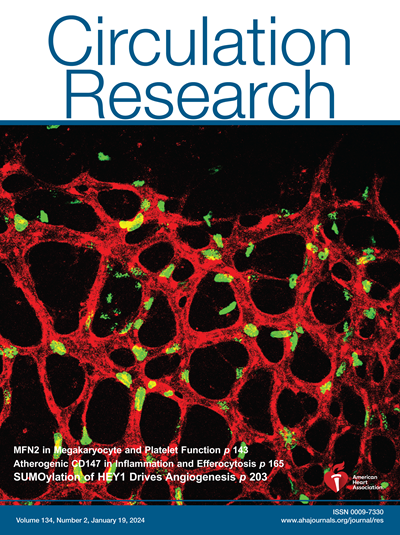动脉肌细胞Pannexin 1通道控制糖尿病高血糖的血管反应性。
IF 16.2
1区 医学
Q1 CARDIAC & CARDIOVASCULAR SYSTEMS
引用次数: 0
摘要
背景:糖尿病高血糖通过激活动脉肌细胞中atp依赖性P2Y11L (p2y11样受体)/AC5(腺苷酸环化酶5)/AKAP5 (A激酶锚定蛋白5)/PKA(蛋白激酶A)/CaV1.2 (l型电压依赖性钙通道1.2)纳米复合物促进血管收缩,但上游机制尚不清楚。我们假设促进ATP释放的Panx1 (pannexin 1)通道与动脉肌细胞中的复合物相关,并介导其激活,诱导糖尿病高血糖时血管收缩。方法采用多学科方法,利用细胞外ATP和cAMP生物传感器、膜片钳电生理学、超分辨率纳米显微镜、近距离结扎试验、压力肌图和激光散斑成像,对野生型和转基因小鼠的动脉肌细胞和血管进行检测,包括诱导平滑肌特异性Panx1基因敲除和全局AKAP5基因敲除。结果:我们发现,细胞外葡萄糖升高(如高糖、高血糖)引发细胞外ATP水平升高,而在诱导的平滑肌特异性Panx1敲除细胞中,Panx1抑制剂螺旋内酯的存在以及通过抑制葡萄糖代谢,使细胞外ATP水平降低。Panx1在动脉肌细胞中与P2Y11L、AC5、AKAP5、PKA和CaV1.2复合物存在。该蛋白复合物在高糖、高血糖时得到强化,这需要Panx1和AKAP5。高糖、高血糖诱导的cAMP生成、CaV1.2增强、持续的血管收缩以及大脑动脉肌张力和血流的体内变化均可通过螺旋内酯和诱导的平滑肌特异性Panx1敲除样本得到改善。Panx1在1型糖尿病小鼠模型(如链脲霉素)的动脉裂解物中表达升高,诱导平滑肌特异性Panx1敲除小鼠的动脉肌细胞和动脉中CaV1.2活性升高和离体和体内肌原性张力增强均被阻止。结论Panx1在动脉肌细胞中通过P2Y11L/AC5/AKAP5/PKA/CaV1.2轴调控ATP信号通路中起关键作用。这种panx1主导的复合物在糖尿病高血糖时调节cAMP水平、CaV1.2活性和血管反应性。因此,Panx1可能成为减轻糖尿病血管并发症的新的治疗靶点。本文章由计算机程序翻译,如有差异,请以英文原文为准。
Arterial Myocyte Pannexin 1 Channel Controls Vascular Reactivity in Diabetic Hyperglycemia.
BACKGROUND
Diabetic hyperglycemia promotes vasoconstriction by activating an ATP-dependent P2Y11L (P2Y11-like receptor)/AC5 (adenylyl cyclase 5)/AKAP5 (A-kinase anchoring protein 5)/PKA (protein kinase A)/CaV1.2 (L-type voltage-dependent calcium channel 1.2) nanocomplex in arterial myocytes, but upstream mechanisms are unclear. We hypothesized that Panx1 (pannexin 1) channels, which facilitate ATP release, are associated with the complex in arterial myocytes and mediate its activation to induce vasoconstriction on diabetic hyperglycemia.
METHODS
Multidisciplinary approach using extracellular ATP and cAMP biosensors, patch-clamp electrophysiology, super-resolution nanoscopy, proximity ligation assay, pressure myography, and laser speckle imaging to test premises in arterial myocytes and vessels from wild-type and genetically modified mice, including an inducible smooth muscle-specific Panx1 knockout and a global AKAP5 knockout.
RESULTS
We found that elevating extracellular glucose (eg, high glucose, hyperglycemia) triggered an increase in extracellular ATP levels, and this was reduced in the presence of the Panx1 inhibitor spironolactone, in inducible smooth muscle-specific Panx1 knockout cells, and by inhibiting glucose metabolism. Panx1 was found in complex with P2Y11L, AC5, AKAP5, PKA, and CaV1.2 in arterial myocytes. The protein complex was strengthened in response to high glucose, hyperglycemia, which required Panx1 and AKAP5. High glucose, hyperglycemia-induced cAMP production, CaV1.2 potentiation, sustained vasoconstriction, and in vivo changes in cerebral artery myogenic tone and blood flow were ameliorated by spironolactone and in inducible smooth muscle-specific Panx1 knockout samples. Panx1 expression was elevated in arterial lysates from a mouse model of type 1 diabetes (eg, streptozotocin), and increased CaV1.2 activity and enhanced ex vivo and in vivo myogenic tone were prevented in arterial myocytes and arteries from inducible smooth muscle-specific Panx1 knockout mice.
CONCLUSIONS
These results suggest a key role for Panx1 in controlling ATP signaling through the P2Y11L/AC5/AKAP5/PKA/CaV1.2 axis in arterial myocytes. This Panx1-led complex modulates cAMP levels, CaV1.2 activity, and vascular reactivity in response to diabetic hyperglycemia. Thus, Panx1 could be a new therapeutic target to mitigate vascular complications during diabetes.
求助全文
通过发布文献求助,成功后即可免费获取论文全文。
去求助
来源期刊

Circulation research
医学-外周血管病
CiteScore
29.60
自引率
2.00%
发文量
535
审稿时长
3-6 weeks
期刊介绍:
Circulation Research is a peer-reviewed journal that serves as a forum for the highest quality research in basic cardiovascular biology. The journal publishes studies that utilize state-of-the-art approaches to investigate mechanisms of human disease, as well as translational and clinical research that provide fundamental insights into the basis of disease and the mechanism of therapies.
Circulation Research has a broad audience that includes clinical and academic cardiologists, basic cardiovascular scientists, physiologists, cellular and molecular biologists, and cardiovascular pharmacologists. The journal aims to advance the understanding of cardiovascular biology and disease by disseminating cutting-edge research to these diverse communities.
In terms of indexing, Circulation Research is included in several prominent scientific databases, including BIOSIS, CAB Abstracts, Chemical Abstracts, Current Contents, EMBASE, and MEDLINE. This ensures that the journal's articles are easily discoverable and accessible to researchers in the field.
Overall, Circulation Research is a reputable publication that attracts high-quality research and provides a platform for the dissemination of important findings in basic cardiovascular biology and its translational and clinical applications.
 求助内容:
求助内容: 应助结果提醒方式:
应助结果提醒方式:


